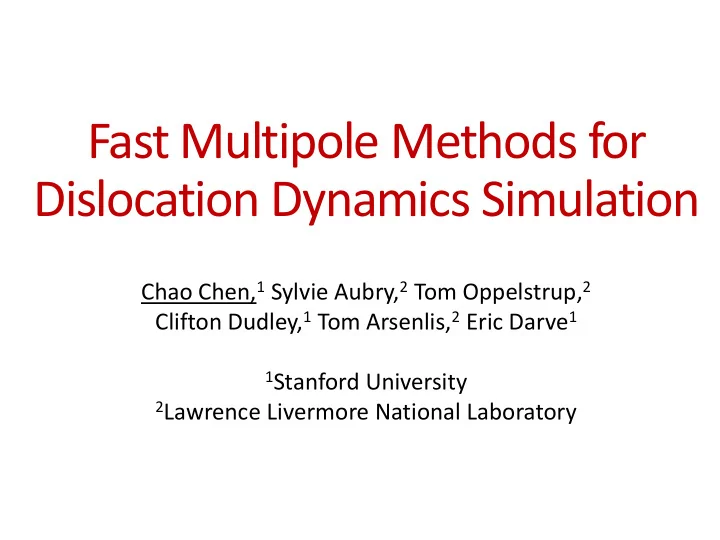

Fast Multipole Methods for Dislocation Dynamics Simulation Chao Chen, 1 Sylvie Aubry, 2 Tom Oppelstrup, 2 Clifton Dudley, 1 Tom Arsenlis, 2 Eric Darve 1 1 Stanford University 2 Lawrence Livermore National Laboratory
Dislocation Interaction Problem: It takes O(N 2 ) flops to evaluate the stress field from N dislocation loops at N points or to compute the interaction force between N loops. (a) 210 dislocation loops (b) Evaluate stress at Gauss grids in every cell
Isotropic Kernel x The stress at from one dislocation loop with C Burger’s vector is given using linear elasticity as b Dislocation dynamics simulations often consider isotropic elasticity, where the kernel is defined with K the derivatives of . R Different fast multipole methods (FMM) have different advantages.
Anisotropic Kernel Extreme environments: high pressure, high temperature or high loading rates. Anisotropic kernel is more complicated and is defined using spherical harmonics. Currently, rarely used due to computational cost. Black-box fast multiple methods are very handy for such kernel.
Fast Multipole Method Reduces the cost from O(N 2 ) to O(N). Two ingredients: (1) Low rank approximation for far-field interactions. . . (2) Hierarchical decomposition. Computing and applying the far-field (M2L) operator is the most expensive step. Fig: Recursively divide the domain
FMM(1): Spherical Harmonics Expand the isotropic kernel using spherical harmonics to construct low rank approximation. Optimization: tensor symmetry, vanishing terms, recurrence relationship of the integrals.
FMM(2): Taylor Series Expand the isotropic kernel in Taylor series. This works for any analytical kernel in principle. Optimization: considering symmetry, only 13 M2L are computed instead of 189.
Analytical Interpolation Approximates the kernel using interpolation. Kernel- independent methods: they only require kernel evaluations. Thanks to the (fixed) interpolation grids, M2L can be pre-computed and accelerated. Expensive M2L
FMM(3): Chebyshev Interpolation Interpolation error is optimal in the infinity-norm. Use SVD to compress M2L.
FMM(4): Uniform Interpolation M2L storage becomes O(p) while they are O(p 2 ) in Chebyshev method, where p is the number of grid points. M2L is a Toeplitz matrix, which enables use of FFT.
Timing Results for Isotropic Kernel Expansion methods are slower. Interpolation methods are faster, but suffer from larger storage needs.
Anisotropic Kernel Easy for interpolation methods: only need kernel evaluations. Hard for expansion methods: requires redo of the math, different implementation and optimization. (a) Chebyshev interpolation (b) Uniform interpolation
Conclusion Expansion methods are specific to the analytical expression. Interpolation methods are black box methods that apply to general kernels; work for cases where the kernel is user- defined (“outside” the FMM library), is complicated, or is only known numerically. Interpolation methods can be very fast because of pre- computation and acceleration of the M2L operator.
Recommend
More recommend